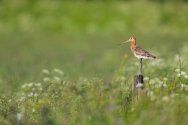
Background
Six dilemmas – part 5: Agriculture and nature: separate or entwined?
Is it better to produce a lot of food on the most fertile soils best suited for agriculture, leaving more room for nature elsewhere? Or should we combine agriculture with nature conservation through, for example, extensive agriculture and wetlands with a food and nature purpose? Both options are considered solutions that will increase food production while conserving nature and biodiversity.
The current intensification and expansion of the farmlands is expected to continue in order to meet the increasing global demand for food. Still, there are grave concerns over the negative impact this may have on the climate, environment and biodiversity. Hence, there is much debate over whether agriculture and nature should be separated or combined. This type of two-pronged thinking ignores the complexity of agriculture and nature conservation. The two approaches are not mutually exclusive.
Degrees of soil use
Agriculture and nature systems are not uniform. There are many degrees, from extensive and wild nature on the one hand to large-scale, intensive agriculture on the other. Many researchers, hence, feel that a combination of the two is required. Separation may be needed to protect specific flora and fauna incompatible with agriculture. Nevertheless, combining is an effective strategy to strengthen ecosystem services essential for agricultural production, such as pollination.
A combination of land-sparing and land-sharing allows an adequate response to local conditions. For example, through high-production agriculture on fertile soils with a good water supply, nature-inclusive agriculture on less fertile soils and nature development on soils ill-suited for agriculture. Furthermore, agriculture does not just drive the deterioration of nature and biodiversity. It can also contribute. Areas with many meadows, for example, can contribute to herb-rich grasslands as a habitat for insects and birds. Biodiversity causes crops to be pollinated, helps fight plagues and keeps soil fertile. Whether such mutual effects can occur must be determined per landscape type.
Optimal range under development
In the Netherlands, the phrase landscape soils was coined to develop combinations of agriculture and nature around Natura 2000 areas. The actual results depend, to a large extent, on how crop farmers or livestock farmers manage their business. Studies are being conducted to investigate what simple measures farmers may take to increase the biodiversity on their property, around meadows, roadsides and the banks of creeks and ditches, without sacrificing too much production soil. There are also developments underway to introduce a greater diversity of crops (planting plan, strip-tilling and mixed tilling) on farmlands. This may lead to a range of options combining agriculture and nature conservation.
6 dilemmas
The societal debate on agriculture and nature frequently focuses on slashing the livestock population in half and whether we should aim to achieve the nitrogen targets in 2030 or in 2035. But are there the right questions? A group of Wageningen researchers identified six dilemmas contributing to the Netherlands’ future course of agriculture and nature.
In the series “6 Dilemmas”, each of the dilemmas is discussed in more detail.


